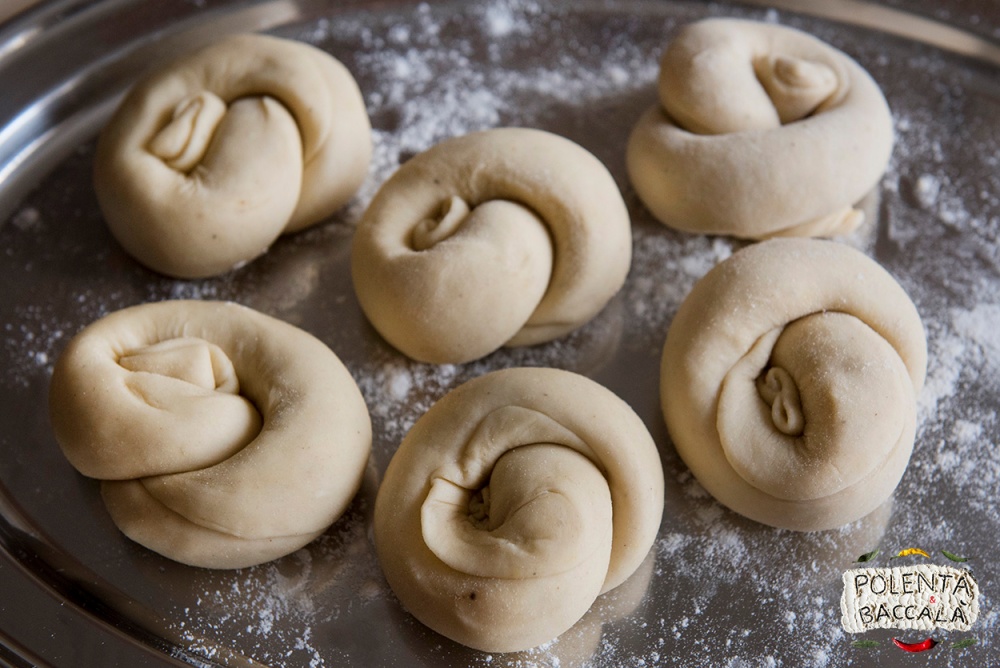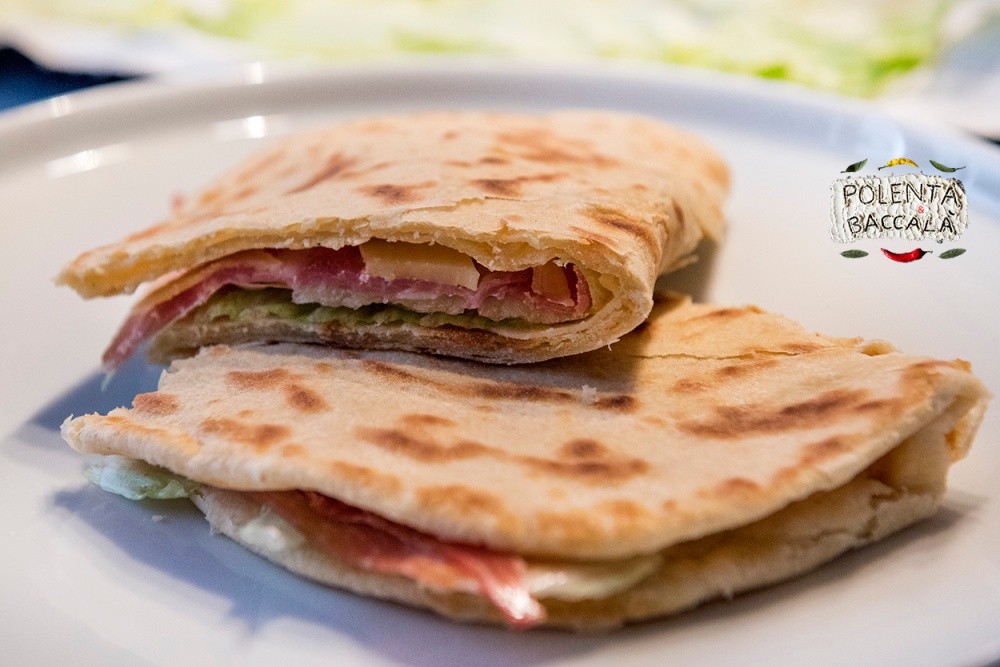
In Italy we have several traditional flatbreads, they are really perfect for those summer days where you want something good but simple, and not too complicated to prepare.
I already showed the most famous of them, the Piadina Romagnola.
This is instead typical of Marche region, neighboring Emilia-Romagna. And like for the piadina romagnola also in this case there are differences between the various areas of the region, possibly even more than for the piadina romagnola.
For example in the area of Urbino the crescia (called here crostolo) it’s more similar in the shape with the piadina of the near Rimini. The difference is that in the dough there is also egg and pepper, and someone use also milk. And traditionally was cooked on a clay plate and not on the “testo” as the piadina. In Urbania it’s even more different, with the white flour substituted with cornmeal.
In the cities of Pesaro and Fano there are other two different types of crescia: the “crescia vonta” which is thicker and passed over a hot plate greased with lard, and the “crescia sfoieta” made with many different layers.
In the city of Ancona the crescia has changed completely its main characteristics, and here is made with a bread dough, it’s thicker and cooked on the grill. It’s traditionally filled with chard or spinach, and local salami and hams. In Jesi it’s similar but also cornmeal it’s used and called “cresciola“.
In Macerata the dough it’s like in Ancona, but extra virgin olive oil is used. Also here there are variants made with cornmeal.
In Ascoli Piceno (in the bottom of the Marche region) the influence of the northern crescia has completely disappeared, the lard is no more used and the tradition here is the “chichì ripieno“, higher and similar to a focaccia. It’s baked and filled with anchovies, capers, bell peppers, olives, tuna and artichokes.
One last thing: in Marche region with the same name Crescia they call also a traditional Easter salty cake (with a panettone shape) which is obviously completely different, made with Pecorino cheese too.
Let’s see now the recipe of the thin version with more layers.
INGREDIENTS (for 6 pieces):
- 500 g flour (a weak flour, as explained in the post about Piadina Romagnola)
- 110-120 g lard (90 g in the dough + 20-30 g to spread on the flattened dough), at room temperature
- 150-170 ml water (or if you prefer 100 water + milk), at room temperature
- 1 egg, at room temperature
- 10 g salt
- some freshly ground black pepper
- a small teaspoon of sodium bicarbonate
- Sift the flour, add the 90 grams of lard, the egg, the salt, the pepper, the sodium bicarbonate and start to mix. Add also the milk and the water and keep working the dough until it’s smooth and no more sticky.
- Cover the dough with a towel and let it rest 20-30 minutes.
- Now divide the dough into 6 balls of about 140-150 grams each. Spread some flour on the working table and flatten the each ball with a rolling pin, at about 3 mm thick. Now take the remaining lard and spread it on all the surface of the flattened dough.

- Then make a roll with the dough and close it on itself making a knot (see the photo). Or roll it like a snail shell.
- Cover them with a towel and let it rest for about 1-2 hours.

- After this time you can flatten your “knots” with a rolling pin and cook in a hot pan. About 1-2 minutes on each side, it will make bubbles and when it gets some darker color it’s ready. Differently than for the normal Piadina Romagnola in this case you don’t have to make holes in the bubbles.

- You must be able to see the layers when you cut it.
- Fill it how you prefer and enjoy 🙂
PS: if you want you can also freeze the “knots” in the case you don’t eat all. Place them on a tray and freeze it for 2-3 hours. After that time you can put them in a freezer bag. When you want to eat them take out from the freezer and wait 2-3 hours before making them flatten.


Looks yummy 🙂
LikeLiked by 1 person
It was 😀 thank you! 🙂
LikeLiked by 1 person
Will you make one for me on my next visit?
LikeLiked by 1 person
Sure 🙂
LikeLiked by 1 person
Also more than one 😀
LikeLiked by 1 person
Yum! Can the lard be replaced with butter or olive oil? Thanks!
LikeLiked by 1 person
Hi 🙂 In the area of origin of this food the tradition is to make it with lard and that’s what most of people do there, but if you would like you can try with extra virgin olive oil, sure 🙂 (but I never tried so I don’t know how will be the inside “layers” in the end).
Let me know! 🙂
LikeLiked by 1 person
Many thanks for your answer. I will let you know how it will end up :P.
LikeLiked by 1 person
Years ago I made this with lard and agree that it’s just not tradition if you substitute with anything else. The flavor is simply not the same! But, being that people are very much health-conscious these days (myself included), occasionally I’ll indulge and pick some up at the supermarket. I was pleasantly surprised to find it in Esselunga!
LikeLiked by 1 person
Well, also in the stores I saw some made with lard, but for sure less 🙂
LikeLike
Appetitosissima! Complimenti!
LikeLiked by 1 person
Grazie 🙂
LikeLike
This recipe reminds me of my Nonna, who is from Gabice mare. I’ve made your recipe many times, exactly as written and love it. Thank you so much for sharing! Looking forward to trying your other recipes.
LikeLiked by 1 person
Thank you, I am glad to hear you liked it!
LikeLike
Q: Do you freeze before or after step 5? Thanks in advance.
LikeLike
Hi, no I don’t freeze. If it’s hot you can put in the fridge, but normally it’s not needed, not in winter for sure 🙂
LikeLike